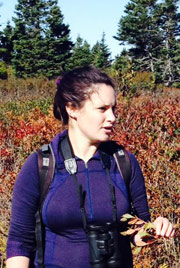Visiting coastal heathlands on Walk With NCC Day
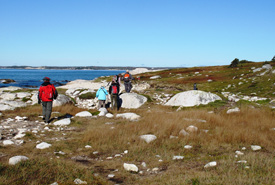
Walking on the Barrens in NS (Photo by NCC)
On a sunny October morning, a group of enthusiastic hikers enjoyed a fall walk through the coastal heathlands on the Nature Conservancy of Canada’s (NCC’s) Dr. Bill Freedman Nature Reserve in Nova Scotia. Our walk started off with a special recognition for Dr. Bill Freedman: an ecologist, conservationist and NCC devotee in whose honour the lands at Prospect High Head have recently been named.
Several of the hikers present were long-time residents of Prospect and the surrounding community, and from them we discovered a great deal about the cultural history of this area. We learned of an old shipwreck just off the coast and the local tradition of maintaining a memorial there honouring this history and the sailors lost. Thick black lettering on a rocky outcrop reads: “HMS Fantome, 18 Gun Brig sank in storm off this shore Nov 24 1814.” As harsh storms erode away the hand-painted message, locals retouch their tribute so their memory never fades.
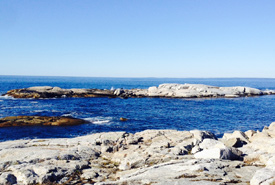
Rocky shoreline on the coast of Prospect, NS (Photo by NCC)
Although far from our minds on such a calm day, we discussed how habitats on the tip of this exposed rocky peninsula are maintained by the extreme force of the Atlantic. Locals know that a sunny, summer day in nearby Halifax is often obscured by fog and wind out on the heaths at Prospect High Head. As stormy as Peggy’s Cove and only a few kilometres to the north of it, the heaths at Prospect High Head are fully exposed to and shaped by the sea.
Large waves spray salt onto the barrens and strong winds from frequent storms sweep across the open landscape, keeping an otherwise encroaching treeline far back from the shore. Shallow soils over the granite scraped by glaciers also make this a less than hospitable environment for plants. Historical farming, induced fire and even footsteps of past hikers likely also have some role in what plant species we saw along our walk.
We followed a winding footpath through plant communities accustomed to a harsh life. The path took us through dwarf heath and tall shrubland, pockets of native grasses, bog wetlands and sparse patches of coastal forest. Recent research in Nova Scotia has revealed that heathlands are a complex mosaic of such diverse, distinctive habitats.
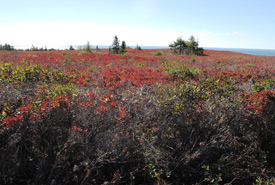
Fall colours at the coastal heathlands in NS (Photo by NCC)
Scientists understand that the Acadian heathlands are at least as botanically rich as forests and that they provide habitat for a great diversity of lichens, some of which are known nowhere else in North America. The flora of Nova Scotia’s heaths are a motley crew of plants from both Arctic and southern environments, high hills and low wetlands, weedy gravelly areas and the forest floor.
A few plants, such as broom crowberry, are uniquely common to Nova Scotia. Several other flowering heathland plants such as Nova Scotia false foxglove or pine barren golden-heather have limited distributions in Canada and are restricted to the Maritimes, where they are also uncommon.
Our walk provided no shortage of spectacular coastal views or intriguing species. Birding expert Bob MacDonald noted that earlier in the fall hikers may encounter uncommon migrants here, such as whimbrels. These shorebirds visit the heaths on NCC lands to rest and forage during their travels. Of particular gustatory interest to whimbrels are the abundant crowberries that dominate the dwarf heaths here and similar heaths around the province.
Like the whimbrels, a few of us were lucky to find ourselves foraging for berries. While it was too late in the season to find crowberries, we discovered a great abundance of a better known treat: cranberries. We learned how to identify two native cranberry species by size, leaf shape and habitat.
Huckleberries were finished fruiting for the season, but these tall shrubs graced us with a bright fall display of showy red foliage. That seemed just as enjoyable! Some adventurous hikers sampled the leaves of our native seaside plantain, named for its salty habitat in marshes and rocky outcrops along our coast, while others tasted juniper berries. From a craft-making perspective, we learned that it’s possible to make candles with bayberry wax.
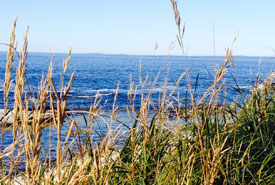
Native grasses and ocean view at Prospect, NS (Photo by NCC)
Several of the group went on a second walk to explore a nearby marsh in search of sweetgrass. We were rewarded with a few leaves of our native potpourri.
With so many ecological, historical and culinary values protected in this one area, it’s easy to see the importance of protecting sites like these. Conservation areas such as the Dr. Bill Freedman Nature Reserve are critical to conserving the heaths that these plants we nibbled on call home.
Heathlands in Nova Scotia cover less than three percent of our province, and coastal areas in particular face pressure from housing developments and other factors. The work of conservation organizations like NCC is especially important in light of this context.

